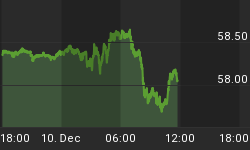The second half of 2008 will be remembered as the era in which justifiably panicked investors fled the global equity markets and flooded into the bond markets, particularly the U.S. Treasury market. As I write this, the migration largely continues.
For those investors and market observers who put a high premium on rationality it seems perverse that so many are accepting the historically low returns offered in the U.S. Treasury market, particularly in the short end, where yields are near zero. At some intra-day prices, yields have even turned negative.
While somewhat bereft of investment merit, I am not surprised by the strong upward moves of U.S. Treasuries, which was by far the best performing asset class of 2008. For better or worse, the majority of investors still consider Treasuries as the ultimate safe haven, and it is therefore understandable that they would rally in times of uncertainty. But now, I urge some caution.
Ian Fleming's hero, 007, used to introduce himself with the signature phrase, "Bond -- James Bond." It struck caution into many of his opponents. Today, at the outset of 2009, the term 'bonds', especially junk bonds, should strike apprehension into the hearts of most conservative investors.
In the initial stages of a recession, it is wise to run to cash, or Treasuries. Emboldened by the healthy returns in Treasuries in 2008, and confidence that government stimuli will provide solvency to the private sector, some investors may be tempted to 'play' the corporate and even junk bond markets as the Fed lowers its key interest rates.
However, as recessions mature, things change subtly. Demand for riskier junk bonds will remain suppressed by the lingering of demand for long-dated Treasuries, which may even increase for two main reasons.
First, there is greater risk that many corporate bond issuers, especially of junk bonds, will collapse and default on their bonds. These growing fears force increasing funds into Treasuries, driving prices ever higher and yields lower.
Second, as historically low yields continue to decline on short-dated Treasuries, many investors who have become focused on current yield rather than on total return, are tempted to move into long dated Treasuries.
In mid-December, the Fed lowered its key rates, putting downward pressure on the U.S. dollar and raising the specter of high inflation. However, sensing the possible sale of long-dated Treasuries, Fed chairman Bernanke took the unusual step of assuring investors that the Fed was likely to buy large amounts of long-dated Treasuries. This caused renewed investor faith in long Treasuries. With Treasury demand thus stimulated, I do not expect a near term rally in corporate debt instruments.
The longer view however is much different. As Fed Chairman Bernanke beckons investors towards long-dated Treasuries, the danger on the rocks is being consistently ignored.
And although these bonds may indeed remain strong for now, it is likely that the revered U.S. Treasury market is becoming the next asset bubble ripe for explosion. Such a dramatic development could be caused by a number of fundamental reasons.
First, as the recession deepens, it will become apparent to all that the Fed has no will to fight inflation. Worse still, it will likely be seen that the U.S. Administration is diverting its vast resources away from restructuring and infrastructure spending towards the potentially inflationary, socialist-style prevention of restructuring through the subsidization of clinically dead companies, like the U.S. auto industry.
Second, the Government can be expected to issue vast amounts of additional long-term debt. Third, foreign central banks will be forced to spend internally on their own domestic stimulus packages. These major investors, especially China, will buy progressively less U.S. Treasuries and may even become major net sellers, driving prices down.
Finally, if America loses its prestigious triple-A credit rating, the prices of its Treasury bonds will plummet.
With the safe haven of U.S. Treasuries threatened, investors may increasingly turn to the refuge of the sovereign debt of hard currency nations, gold and even to the top rated companies in economies like China, where the government has massive amounts of cash to spend on competitive restructuring and infrastructure.
In short, risky U.S. debt instruments will have no fundamental drivers in 2009. U.S. government debt has a brighter short term future but in the end may be just as dangerous.
For a more in-depth analysis of our financial problems and the inherent dangers they pose for the U.S. economy and U.S. dollar, read Peter Schiff's just released book "The Little Book of Bull Moves in Bear Markets." Click here to order your copy now.
For a look back at how Peter predicted our current problems read the 2007 bestseller "Crash Proof: How to Profit from the Coming Economic Collapse." Click here to order a copy today.
More importantly, don't wait for reality to set in. Protect your wealth and preserve your purchasing power before it's too late. Discover the best way to buy gold at www.goldyoucanfold.com. Download Euro Pacific's free Special Report, "The Powerful Case for Investing in Foreign Securities" at www.researchreportone.com. Subscribe to our free, on-line investment newsletter, "The Global Investor" at http://www.europac.net/newsletter/newsletter.asp.
















